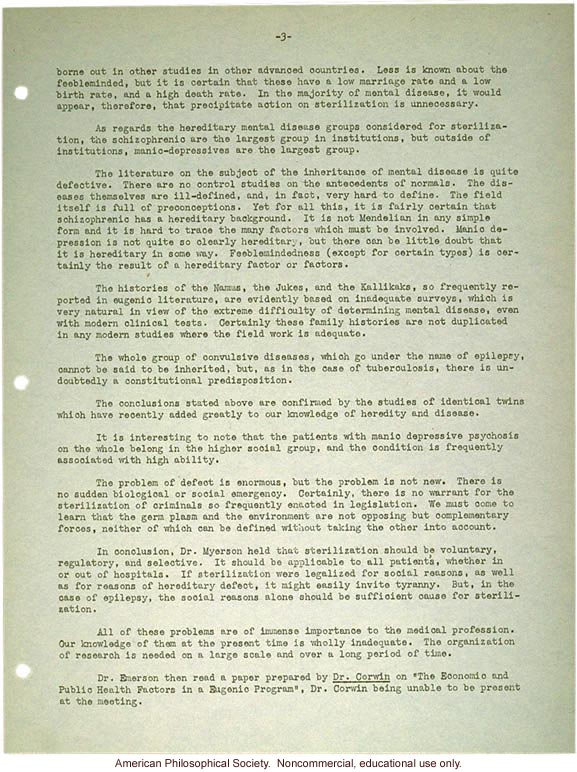[page number] -3- [end page number]
borne out in other studies in other advanced countries. Less is known about the feebleminded, but it is certain that these have a low marriage rate and a low birth rate, and a high death rate. In the majority of mental disease, it would appear, therefore, that precipitate action on sterilization is unnecessary.
As regards the hereditary mental disease groups considered for sterilization, the schizophrenic are the largest group in institutions, but outside of institutions, manic-depressives are the largest group.
The literature on the subject of the inheritance of mental disease is quite defective. There are no control studies on the antecedents of normals. The diseases themselves are ill-defined, and, in fact, very hard to define. The field itself is full of preconceptions. Yet for all this, it is fairly certain that schizophrenic has a hereditary background. It is not Mendelian in any simple form and it is hard to trace the many factors which must be involved. Manic depression is not quite so clearly hereditary, but there can be little doubt that it is hereditary in some way. Feeblemindedness (except for certain types) is certainly the result of a hereditary factor or factors.
The histories of the Namms, the Jukes, and the Kallikaks, so frequently reported in eugenic literature, are evidently based on inadequate surveys, which is very natural in view of the extreme difficulty of determining mental disease, even with modern clinical tests. Certainly these family histories are not duplicated in any modern studies where the field work is adequate.
The whole group of convulsive diseases, which go under the name of epilepsy, cannot be said to be inherited, but, as in the case of tuberculosis, there is undoubtedly a constitutional predisposition.
The conclusions stated above are confirmed by the studies of identical twins which have recently added greatly to our knowledge of heredity and disease.
It is interesting to note that the patients with manic depressive psychosis on the whole belong in the upper social group, and the condition is frequently associated with high ability.
The problem of defect is enormous, but the problem is not new. There is no sudden biological or social emergency. Certainly, there is no warrant for the sterilization of criminals so frequently enacted in legislation. We must come to learn that the germ plasm and the environment are not opposing but complementary forces, neither of which can be defined without taking the other into account.
In conclusion, Dr. Myerson held that sterilization should be voluntary, regulatory, and selective. It should be applicable to all patients, whether in or out of hospitals. If sterilization were legalized for social reasons, as well as for reasons of hereditary defect, it might easily invite tyranny. But, in the case of epilepsy, the social reasons alone should be sufficient cause for sterilization.
All of these problems are of immense importance to the medical profession. Our knowledge of them at the present time is wholly inadequate. The organization of research is needed on a large scale and over a long period of time.
Dr. Emerson then read a paper prepared by Dr. Corwin on "The Economic and Public Health Factors in a Eugenic Program", Dr. Corwin being unable to be present at the meeting.


